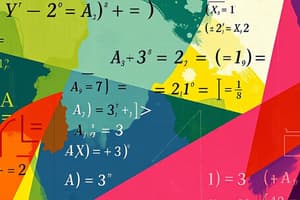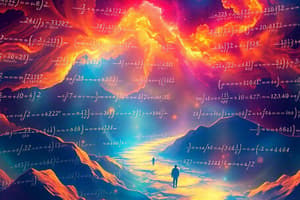Podcast
Questions and Answers
What is the main purpose of variables in algebra?
What is the main purpose of variables in algebra?
- To represent fixed numerical values
- To perform operations like addition and subtraction
- To graph equations
- To represent unknown values (correct)
Which of the following is true about linear equations?
Which of the following is true about linear equations?
- They can only have one variable
- They form a curve when graphed
- The highest exponent of the variable is always one (correct)
- They can have variables raised to any power
In the slope-intercept form of a linear equation, what does the 'b' represent?
In the slope-intercept form of a linear equation, what does the 'b' represent?
- The y-intercept of the line (correct)
- The maximum value of the function
- The point where the line crosses the x-axis
- The slope of the line
What is an example of an expression in algebra?
What is an example of an expression in algebra?
What describes a system of linear equations that has no solution?
What describes a system of linear equations that has no solution?
Which operation is NOT commonly used with algebraic expressions?
Which operation is NOT commonly used with algebraic expressions?
When converting to standard form from slope-intercept form (y = mx + b), what is crucial?
When converting to standard form from slope-intercept form (y = mx + b), what is crucial?
Which type of algebra focuses on vector spaces and linear mappings?
Which type of algebra focuses on vector spaces and linear mappings?
Match the following geometric terms with their definitions:
Match the following geometric terms with their definitions:
Match the 2-D shapes with their properties:
Match the 2-D shapes with their properties:
Match the types of triangles with their descriptions:
Match the types of triangles with their descriptions:
Match the following 2-D shapes with their categories:
Match the following 2-D shapes with their categories:
Match the 2-D shape with its area formula:
Match the 2-D shape with its area formula:
Match the following shape properties with their definitions:
Match the following shape properties with their definitions:
Match the types of polygons with their number of sides:
Match the types of polygons with their number of sides:
Match the different conditions of quadrilaterals with their characteristics:
Match the different conditions of quadrilaterals with their characteristics:
Flashcards are hidden until you start studying
Study Notes
Algebra
-
Definition: Branch of mathematics dealing with symbols and the rules for manipulating those symbols.
-
Key Concepts:
- Variables: Symbols (often x, y, z) representing unknown values.
- Constants: Fixed values (e.g., numbers like 2, -5).
- Expressions: Combinations of variables, constants, and operations (e.g., 3x + 2).
- Equations: Mathematical statements asserting the equality of two expressions (e.g., 2x + 3 = 7).
-
Operations:
- Addition and Subtraction: Combine or remove terms.
- Multiplication and Division: Scale terms or split them.
- Exponents: Indicates repeated multiplication of a base (e.g., x² means x multiplied by itself).
-
Types of Algebra:
- Elementary Algebra: Basics of algebraic equations and operations.
- Abstract Algebra: Studies algebraic structures like groups, rings, and fields.
- Linear Algebra: Focuses on vector spaces and linear mappings.
Linear Equations
-
Definition: An equation in which the highest exponent of the variable is one, forming a straight line when graphed.
-
Standard Form: Ax + By = C, where A, B, and C are constants.
-
Slope-Intercept Form: y = mx + b, where:
- m = slope of the line (rise over run).
- b = y-intercept (point where the line crosses the y-axis).
-
Graphing Steps:
- Identify slope (m) and y-intercept (b).
- Plot the y-intercept on the graph.
- Use the slope to find another point.
- Draw a straight line through the points.
-
Solutions:
- A linear equation can have:
- One solution: Intersects the line at one point (consistent).
- No solution: Parallel lines (inconsistent).
- Infinitely many solutions: Same line represented in different forms (dependent).
- A linear equation can have:
-
Systems of Linear Equations:
- Set of two or more linear equations with the same variables.
- Can be solved using:
- Graphical Method: Graph each equation and identify intersection.
- Substitution Method: Solve one equation for a variable and substitute into the other.
- Elimination Method: Add or subtract equations to eliminate a variable.
Algebra
- A branch of mathematics focusing on symbols and their manipulation rules.
- Variables are symbols like x, y, and z that represent unknown values.
- Constants are fixed values, such as numbers like 2 or -5, that do not change.
- Expressions combine variables, constants, and operations, for example, 3x + 2.
- Equations are mathematical assertions of equality between two expressions, such as 2x + 3 = 7.
- Operations include:
- Addition and Subtraction: Combine or remove terms from expressions.
- Multiplication and Division: Scale terms or divide them.
- Exponents: Represent repeated multiplication of a base, e.g., x² is x multiplied by itself.
- Types of Algebra encompass:
- Elementary Algebra: Covers the fundamentals of equations and operations.
- Abstract Algebra: Studies structures such as groups, rings, and fields.
- Linear Algebra: Focused on vector spaces and linear mappings.
Linear Equations
- Defined as equations where the highest variable exponent is one, creating a straight line when graphed.
- Standard Form is expressed as Ax + By = C, with A, B, and C as constants.
- Slope-Intercept Form is y = mx + b, with:
- m indicating the slope of the line (rise/run).
- b representing the y-intercept (where the line crosses the y-axis).
- Graphing Steps involve:
- Identifying the slope (m) and y-intercept (b).
- Plotting the y-intercept on a graph.
- Using the slope to determine another point on the line.
- Drawing a straight line through the identified points.
- Solutions for linear equations can be:
- One solution: The line intersects at a single point (consistent).
- No solution: The lines are parallel (inconsistent).
- Infinitely many solutions: The same line represented in multiple forms (dependent).
- Systems of Linear Equations consist of two or more linear equations sharing variables, solvable by:
- Graphical Method: Graphing each equation to find intersections.
- Substitution Method: Solving one equation for a variable and substituting into another.
- Elimination Method: Adding or subtracting equations to eradicate a variable.
Geometry Overview
- Geometry is a mathematical discipline focused on the characteristics and relationships of points, lines, surfaces, and solids.
- Key elements include points (dimensionless locations), lines (one-dimensional figures extending infinitely), and planes (two-dimensional surfaces that extend infinitely).
Two-Dimensional Shapes
- Two-dimensional shapes are flat figures characterized solely by length and width, lacking depth.
Common 2-D Shapes
-
Circle:
- Defined by all points being equidistant from a central point.
- Important properties include radius, diameter, and circumference.
-
Triangle:
- A three-sided polygon with three fundamental types:
- Equilateral (equal sides)
- Isosceles (two equal sides)
- Scalene (all sides different)
- The sum of interior angles in a triangle is always 180 degrees.
- A three-sided polygon with three fundamental types:
-
Square:
- A four-sided polygon (quadrilateral) with all sides equal and angles of 90 degrees.
- Area calculated as side squared (Area = side²) and perimeter as four times the side (Perimeter = 4 × side).
-
Rectangle:
- A quadrilateral with opposite sides equal and all angles measuring 90 degrees.
- Area determined by length times width (Area = length × width) and perimeter by doubling the sum of length and width (Perimeter = 2(length + width)).
-
Polygon:
- A closed figure formed by three or more straight sides; examples include:
- Pentagon (5 sides)
- Hexagon (6 sides)
- Heptagon (7 sides)
- A closed figure formed by three or more straight sides; examples include:
-
Trapezoid (US)/Trapezium (UK):
- A quadrilateral possessing at least one pair of parallel sides.
-
Rhombus:
- A quadrilateral with equal-length sides but not required to have right angles.
-
Parallelogram:
- A quadrilateral with both pairs of opposite sides parallel and equal in length.
Properties of 2-D Shapes
- Area: Represents the total space enclosed within a shape.
- Perimeter: The total distance surrounding a shape.
- Symmetry: A shape is symmetrical if it can be split into two parts that mirror each other.
Applications
- The principles of geometry find practical use in diverse fields such as architecture, engineering, graphic design, and everyday problem-solving tasks.
Studying That Suits You
Use AI to generate personalized quizzes and flashcards to suit your learning preferences.




